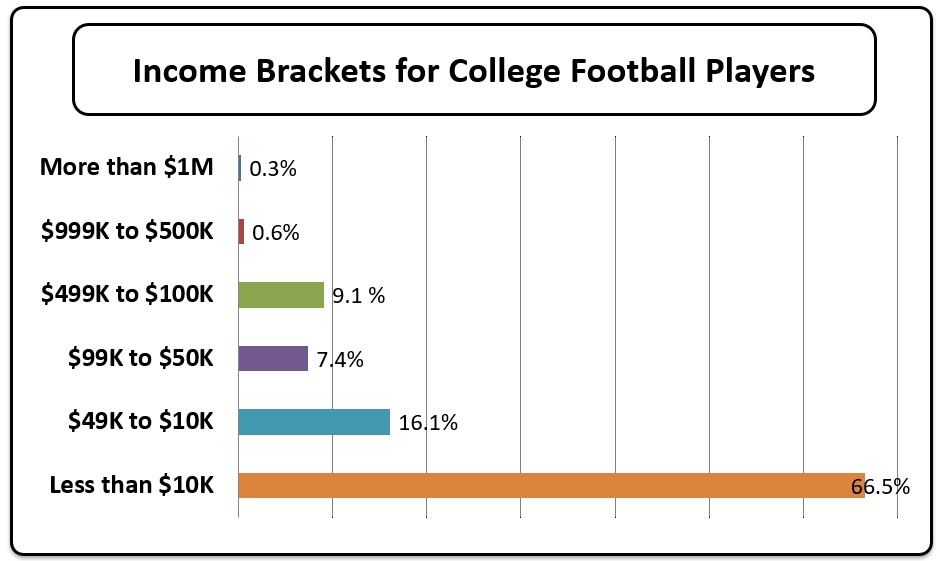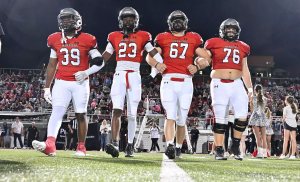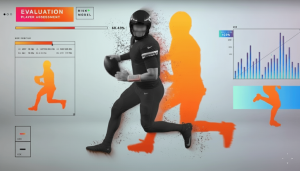When people talk about NIL (Name, Image, Likeness) money in college sports, they often picture big deals, flashy gear, viral TikToks, and athletes rolling in sponsorship cash. And yes, that’s happening, but just for a few! If you lay out the stats, the real picture is far more uneven.
Here’s what the latest data reveals, plus what it means, who’s winning, and what needs to change.
Let’s Talk Numbers
This latest data from Opendorse says it all:
- Only 0.3% of players earn more than $1 million.
- Another 0.6% make somewhere between $500K–$999K.
- 9.1% sit in the $100K–$499K range.
- 7.4% earn $50K–$99K.
- 16.1% are in the $10K–$49K bracket.
- However, the vast majority, again, a massive 66.5%, earn under $ 10,000.

Income Brackets for College Football Players. Credits: Opendorse
Why the Numbers Matter
On paper, college football NIL is a $1.9 billion market.
. But this graph makes one thing clear: the money is not evenly distributed.
- The top 1% of players capture the headlines and the seven-figure contracts.
- A slim 10–15% in the middle makes enough to feel a difference, maybe cover tuition, rent, or build savings.
- The overwhelming majority, two out of every three athletes, are making token amounts, the equivalent of a side hustle, not a career-changer.
This isn’t laziness or lack of talent. It’s the structure of the market: NIL favors high-profile positions, big-brand schools, and athletes with social media clout.
Why the Gap is So Huge
That graph doesn’t exist in a vacuum. Other recent developments explain how this wide gulf forms:
- The Power 5 / Power 4 (i.e., the biggest conferences) schools are getting most of the action: the largest NIL collectives, the biggest booster support, and the most media visibility.
- Collectives (groups of boosters, community sponsors, etc.) are generating, on average, ~$10 million per Power 5 school.
- New rules allow schools to share up to $20.5 million of their revenue with athletes via revenue sharing. Meaning the total available NIL pot is growing, but also that how schools distribute it matters a ton.
- Even among Power 5 schools, there’s a hierarchy: Ohio State, Texas, Georgia, Alabama, etc, are near the top spenders. The Group of Five schools (smaller conferences) mostly lag far behind.
- There are many NIL deals — just in one recent update, over 8,300 NIL deals worth nearly $80 million were approved between June and August 2025. That shows demand is huge, but again: that $$ is not evenly distributed.
What This Means If You’re a Player (Or Thinking Like One)
Here are some realities:
- Visibility + Branding = Big Edge
If you’re a quarterback, wide receiver, or otherwise in a high‐visibility role, especially at a school with lots of media exposure, you’re gonna have a much better shot. The “marketable athlete” gets more NIL regardless of pure on‐field contribution sometimes. - School Matters More Than Ever
If you go to a school with strong NIL collectives, high donor support, a big fan base, and good social media, your chances of scoring decent NIL income go up a lot. If you’re at a less famous school, you might be working just as hard with way less payoff. - Almost All Players Are Hustling
For the 66.5% making < $10K, NIL is probably not paying rent. It’s maybe helping with gear, maybe travel, maybe saving up, maybe putting food on the table. But it’s rarely life-changing for most. The top ~10% are the outliers, making enough actually to shift life trajectories.
What’s Changing & What’s Coming
Some shifts to watch:
- With the revenue-sharing rules now in place (2025-26), schools have to think about how they distribute more consistent NIL funds. Not just through boosters but directly. That could pull up the floor or at least help widen the middle.
- NIL platforms/reporting is improving. More transparency = more pressure to be fairer.
- Some schools are aggressive, others are conservative. For example, Duke reportedly committed $8 million for a transfer QB, Darian Mensah, over two years. That single-player deal is enormous compared to what many get.
Caveats & Concerns
- Inequality is baked in: Media rights, fan bases, and historic prestige all give certain schools & players big advantages. That’s not new, but NIL amplifies it.
- Smaller schools may struggle: Without large collectives or wealthy boosters, many schools might fall further behind.
- Potential unintended consequences: Athletes might choose schools based more on NIL potential than on best coaching, fit, or academics. Also, the risk of NIL becoming an arms race.
- Mental / personal cost: Managing branding, sponsors, content, social media, etc., is extra work and not every athlete wants that or has the tools.
My Two Cents: How Things Could Improve
Since I like thinking outside the box:
- Schools need more minimum NIL guarantees for non-star players. Even small stipends, base deals, so everyone gets something fair.
- More transparency in how collectives operate. If athletes know what they’re competing against, what benchmarks boosters expect, it levels the game.
- Support services: teaching players how to brand themselves, manage deals, taxes, etc., so even if they don’t have millions, they maximize what they get.
- Ensuring smaller schools & non-Power conferences get more visibility & institutional support (media coverage, collective funding, etc.).
It’s Better Than Before, But Still a Long Road
I’ll be honest: NIL did move the needle.
Athletes can now monetize in ways they couldn’t before. Big contracts, real recognition, more power. That’s good. But the numbers show that it is still mostly a win for a small group. Most are still hoping to get to the top with much less than people assume.
For fairness, for equity, for the idea that all college athletes deserve respect, the system needs some fair changes. Because right now, the hype sometimes outpaces reality. And that’s okay, we just need to know what we’re dealing with!



